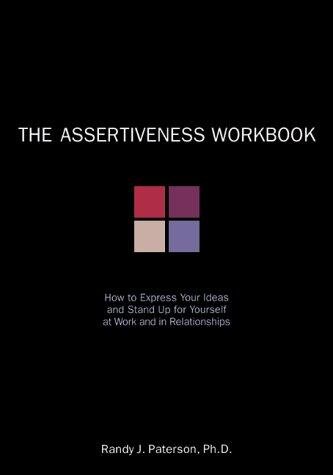Randy J. Paterson, Ph.D., The Assertiveness Workbook: How to Express Your Ideas and Stand Up for Yourself at Work and in Relationships. New Harbinger Publications, 2000.
Referenced in: Church Conflict – Criticism, Difficult People, Difficult Relationships
LifeandLeadership.com Summary
This is an excellent workbook. It is just that, a workbook, and not something one should simply read, but also use. It is not targeted to church leaders, but is easily translated into that context. Each chapter provides helpful insight into assertiveness interspersed with reflective assessments and exercises that lead one into ever-increasing skill levels. Below is a chapter-by-chapter summary.
Part One — Understanding Assertiveness
- Chapter 1, What is Assertiveness? Distinguishes between passive, aggressive, passive-aggressive, and assertive behaviors and includes a reflective assessment.
- Chapter 2 — Overcoming the Stress Barrier. Explains one of the main barriers to being able to use assertive skills, stress. They offer a calming mechanism of situation-appraisal-response as well as a number of suggestions on how to respond more productively to stress physically and emotionally.
- Chapter 3 — Overcoming the Social Barrier. Discusses strategies to deal with the opposition many experience from their friends and associates when they try assertiveness with them.
- Chapter 4 — Overcoming the Belief Barrier. Suggests how to adopt more accurate beliefs about our reality and place more truthful interpretations on our life events. Surveys beliefs and interpretations that are characteristic of the passive, aggressive, and passive-aggressive postures.
- Chapter 5 — Reality Check. Does the same as the previous chapter in offering helpful beliefs and interpretations that support assertive behaviors.
- Chapter 6 — On the Launchpad: Preparing for Change: Coaches on how to ease into assertive behavior, when it is and is not appropriate.
Part Two — Becoming Assertive
- Chapter 7 — Becoming Visible: Non-Verbal Behavior. Discusses posture, movements, gestures, physical distance, eye contact, facial expression, physical contact, voice tone, fluency, and physical appearance. Includes helpful exercises and scripted rehearsals.
- Chapter 8 — Being Present: Giving Your Opinion.
- Chapter 9 — Taking the Good: Receiving Positive Feeback
- Chapter 10 — Giving Helpful Positive Feeback
- Chapter 11 — Taking the Valuable: Receiving Negative Feeback. An excellent chapter on navigating criticism, whether it is nonverbal, indirect, hostile, or direct,
- Chapter 12 — Constructive, Not Critical: Giving Corrective Feeback
- Chapter 13 — The Assertive “No”
- Chapter 14 — Making Requests Without Controlling Others
- Chapter 15 — Countdown to Confrontation
- Chapter 16 — Constructive Confrontation
From the Publisher
Effective communication is a critical skill that influences your professional success, the stability of your family life, and your personal happiness. Your ability to communicate effectively is seriously hampered if you can’t assert yourself constructively. If you’ve ever felt paralyzed by an imposing individual or strongly argued opposing point of view, you know that a lack of assertiveness can leave you feeling marginalized and powerless. The Assertiveness Workbook contains effective, cognitive behavioral techniques to help you become more assertive. Learn how to set and maintain personal boundaries without becoming inaccessible. Become more genuine and open in relationships without fearing attack. Defend yourself when you are criticized or asked to submit to unreasonable requests.
About the Author
Randy J. Paterson, Ph.D., is a clinical psychologist and the coordinator of Changeways, a widely-known depression treatment program at Vancouver Hospital and Health Sciences Centre. He is also an adjunct assistant professor at the Department of Psychology at the University of British Columbia. He lives in Vancouver, BC.
***For additional information on this resource, including reviews, click the bookstore links. Check the reference at page top or the links below for resource guides on related topics.***
Related Areas
See Other Resources on Church Conflict:
See Resources on Over 100 Areas of Ministry Leadership:


